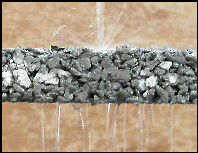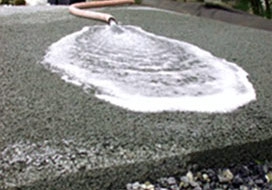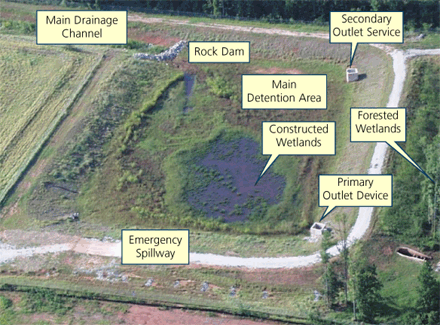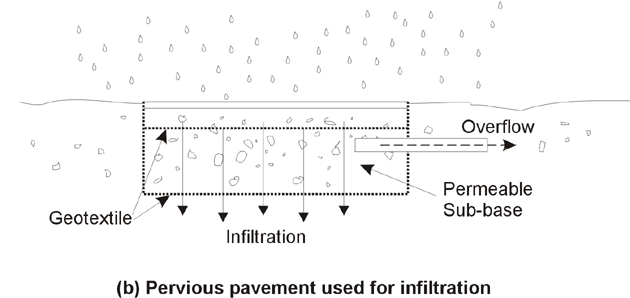What Is Pervious?

 Pervious concrete is a special type of concrete with a high porosity used for concrete flatwork applications that allows water from precipitation and other sources to pass directly through, thereby reducing the runoff from a site and allowing groundwater recharge. The high porosity is attained by a highly interconnected void content. Typically pervious concrete has little or no fine aggregate and has just enough cementitious paste to coat the coarse aggregate particles while preserving the interconnectivity of the voids. Pervious concrete is traditionally used in parking areas, areas with light traffic, residential streets, pedestrian walkways, and greenhouses. It is an important application for sustainable construction and is one of many low impact development techniques used by builders to protect water quality.
Pervious concrete is a special type of concrete with a high porosity used for concrete flatwork applications that allows water from precipitation and other sources to pass directly through, thereby reducing the runoff from a site and allowing groundwater recharge. The high porosity is attained by a highly interconnected void content. Typically pervious concrete has little or no fine aggregate and has just enough cementitious paste to coat the coarse aggregate particles while preserving the interconnectivity of the voids. Pervious concrete is traditionally used in parking areas, areas with light traffic, residential streets, pedestrian walkways, and greenhouses. It is an important application for sustainable construction and is one of many low impact development techniques used by builders to protect water quality.
Stormwater Management
 As regulations further limit stormwater runoff, it is becoming more expensive for property owners to develop real estate, due to the size and expense of the necessary drainage systems as seen at the left. The proper utilization of pervious concrete is a recognized Best Management Practice by the U.S. Environmental Protection Agency (EPA) for providing first flush pollution control and stormwater management. Pervious concrete reduces the runoff from paved areas, which reduces the need for separate stormwater retention ponds and allows the use of smaller capacity storm sewers. This allows property owners to develop a larger area of available property at a lower cost. Pervious concrete also naturally filters storm water and can reduce pollutant loads entering into streams, ponds and rivers.
As regulations further limit stormwater runoff, it is becoming more expensive for property owners to develop real estate, due to the size and expense of the necessary drainage systems as seen at the left. The proper utilization of pervious concrete is a recognized Best Management Practice by the U.S. Environmental Protection Agency (EPA) for providing first flush pollution control and stormwater management. Pervious concrete reduces the runoff from paved areas, which reduces the need for separate stormwater retention ponds and allows the use of smaller capacity storm sewers. This allows property owners to develop a larger area of available property at a lower cost. Pervious concrete also naturally filters storm water and can reduce pollutant loads entering into streams, ponds and rivers.
Pervious concrete functions like a storm water infiltration basin and allows the storm water to infiltrate the soil over a large area, thus facilitating recharge of precious groundwater supplies locally. All of these benefits lead to more effective land use. Pervious concrete can also reduce the impact of development on trees. A pervious concrete pavement allows the transfer of both water and air to root systems allowing trees to flourish even in highly developed areas.
Construction
An experienced installer is vital to the success of pervious concrete pavements. As with any concrete pavement, proper subgrade preparation is important. The subgrade should be properly compacted to provide a uniform and stable surface. When pervious pavement is placed directly on sandy or gravelly soils it is recommended to compact the subgrade to 92% to 96% of the maximum density. With silty or clayey soils, the level of compaction will depend on the specifics of the pavement design and a layer of open graded stone may have to be placed over the soil. Engineering fabrics are often used to separate fine-grained soils from the stone layer. Care must be taken not to over-compact soil with swelling potential. The subgrade should be moistened prior to concrete placement, and wheel ruts from the construction traffic should be raked and re-compacted.
 Typically pervious concrete has a water to cementitious materials (w/cm) ratio of 0.25 to 0.35 with a void content of 15% to 25%. The mixture is composed of cementitious materials, coarse aggregate and water with little to no fine aggregates. Addition of a small amount of fine aggregate will generally reduce the void content and increase the strength, which may be desirable in certain situations. This material is sensitive to changes in water content, so field adjustment of the fresh mixture is usually necessary. The correct quantity of water in the concrete is critical. Too much water will cause segregation, and too little water will lead to balling in the mixer and very slow mixer unloading. Whereas some loose stones can always be expected on a pervious concrete surface, too low a water content can hinder adequate curing of the concrete and lead to a premature raveling surface failure. A properly proportioned mixture gives the mixture a wet-metallic appearance or sheen.
Typically pervious concrete has a water to cementitious materials (w/cm) ratio of 0.25 to 0.35 with a void content of 15% to 25%. The mixture is composed of cementitious materials, coarse aggregate and water with little to no fine aggregates. Addition of a small amount of fine aggregate will generally reduce the void content and increase the strength, which may be desirable in certain situations. This material is sensitive to changes in water content, so field adjustment of the fresh mixture is usually necessary. The correct quantity of water in the concrete is critical. Too much water will cause segregation, and too little water will lead to balling in the mixer and very slow mixer unloading. Whereas some loose stones can always be expected on a pervious concrete surface, too low a water content can hinder adequate curing of the concrete and lead to a premature raveling surface failure. A properly proportioned mixture gives the mixture a wet-metallic appearance or sheen.
A pervious concrete pavement may be placed with either fixed forms or slip-form paver. The most common approach to placing pervious concrete is in forms on grade that have a riser strip on the top of each form such that the strike off device is actually 3/8-1/2 in. (9 to 12 mm) above final pavement elevation. Strike off may be by vibratory or manual screeds, though vibratory screens are preferable. After striking off the concrete, the riser strips are removed and the concrete compacted by a manually operated roller that bridges the forms. Rolling consolidates the fresh concrete to provide strong bond between the paste and aggregate, and creates a smoother riding surface. Excessive pressure when rolling should be avoided as it may cause the voids to collapse. Rolling should be performed immediately after strike off.
Jointing pervious concrete pavement follows the same rules as for concrete slabs on grade, with a few exceptions. The rules of jointing geometry, however, remain the same. Joints in pervious concrete are tooled with a rolling jointing tool. This allows joints to be cut in a short time, and allows curing to continue uninterrupted. Proper curing is essential to the structural integrity of a pervious concrete pavement. Curing ensures sufficient hydration of the cement paste to provide the necessary strength in the pavement section to prevent raveling. Curing should begin within 20 minutes of concrete discharge and continue through 7 days. Plastic sheeting is typically used to cure pervious concrete pavements.
Testing and inspection
Pervious concrete can attain a compressive strength ranging from 400 psi to 4000 psi (2.8 to 28 MPa) though strengths of 600 psi to 1500 psi (2.8 to 10 MPa) are more common. Pervious concrete, however, is not specified or accepted based on strength as there are not yet standardized test methods.More important to the success of a pervious pavement is the void content. Acceptance is typically based on the density (unit weight) of the in-place pavement. An acceptable tolerance is plus or minus 5 lb/cu.ft. (80 kg/m3) of the design density. This should be verified through field testing. The fresh density (unit weight) of pervious concrete is measured using the test method described in ASTM C1688.Slump and air content tests are not applicable to pervious concrete. If the pervious concrete pavement is an element of the storm water management plan, the designer should ensure that it is functioning properly through visual observation of its drainage characteristics prior to opening of the facility. Questions have been raised about the freeze thaw durability of pervious concrete. Pervious concrete in freeze thaw environments must not become fully saturated. Saturation of installed pervious concrete pavement can be prevented by placing the pervious concrete on a thick layer of 8 to 24 inches (200 to 600 mm) of open graded stone base. Laboratory testing has shown that entrained air may improve the freeze thaw durability even when the pervious concrete is in a fully saturated condition. However, the entrained air content cannot be verified by any standard ASTM test procedure.
EPA recommends that pervious concrete pavement be cleaned regularly to prevent reduction in permeability. Cleaning can be accomplished through vacuum sweeping or pressure washing.
